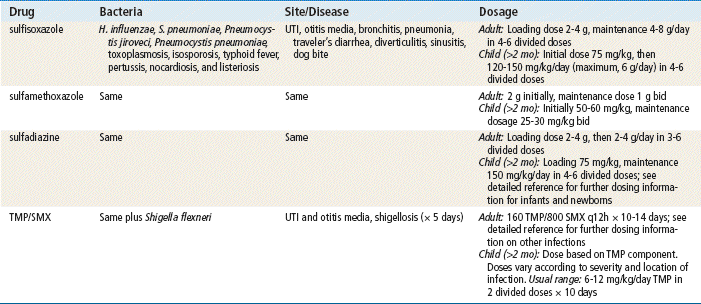http://evolve.elsevier.com/Edmunds/NP/
The sulfonamides have a wide antibacterial spectrum that includes both gram-positive and gram-negative organisms; they are most commonly used for UTIs. Sulfonamide therapy continues to have a place in the treatment or prophylaxis of specific clinical conditions such as Pneumocystis pneumonia, toxoplasmosis, isosporosis, typhoid fever, pertussis, nocardiosis, and listeriosis. Strains of community-acquired methicillin-resistant Staphylococcus aureus (CA-MRSA) have emerged as an important group of pathogens. Sulfonamides and tetracycline antibiotics remain valuable low-cost agents for use with most CA-MRSA soft tissue and skin infections.
Frequent allergic reactions and drug resistance limit the more extensive use of sulfonamides. Sulfamethoxazole is combined with trimethoprim (TMP/SMX) for its synergistic effect and is the most commonly used of the sulfonamides. Silver sulfadiazine is frequently used in wound infections and burns. Sulfonamides are divided into four classes. Two are systemic antibiotics (short acting and long acting); for topical infections and bowel problems. Short-acting agents are rapidly absorbed and rapidly eliminated. Long-acting agents are rapidly absorbed but are excreted slowly. No long-acting sulfonamides are currently available in the United States because of associated toxicity, especially seen as Stevens-Johnson syndrome. Poorly absorbed sulfonamides are used to treat infections of the bowel and to prepare individuals for surgery. Topicals include sulfonamides that are not absorbed systemically; these are used topically, particularly in the eye and ear. The first antibiotic was a sulfonamide that was developed by the German dye industry; it was first used in 1932 against streptococcal infection.
Therapeutic Overview
Sulfonamide or “sulfa” allergy is fairly common, occurring in about 6% of the general population. Allergic reactions to sulfonamides are divided into type 1 (immediate hypersensitivity) and types 2 to 4 (IgG and IgM antibody, and T-cell mediated). Allergies occur to sulfonamide metabolites at the N1 and N4 amino nitrogen on the heterocyclic ring. Only the antibiotic sulfonamide drugs have this structure. Nonantibiotic sulfonamide drugs do not contain this structure. Although much concern has been expressed about cross-allergy with other drugs that contain a sulfonamide functional group, research has shown that this does not occur. A theoretical possibility remains that a T-cell–mediated allergy could possibly be related to the sulfonamide compound. This has not yet been demonstrated. The fact that people who have an allergy to a drug often have many allergies confuses the picture. For example, some patients have an allergy to penicillin and an allergy to cephalosporins that are not related. The data suggest that patients who are allergic to sulfonamide antibiotics do not need to avoid nonantibiotic sulfonamides.
Type 1 immediate sensitivity reactions include anaphylaxis, urticaria, angioedema, and hypotension that occur within 30 minutes of drug administration. Type 2 hypersensitivity (cytotoxic) reactions cause hemolytic anemias, neutropenias, thrombocytopenias, and vasculitides, which generally become apparent within 7 to 14 days of administration. Type 3 hypersensitivity reactions affect entire organs. Skin, joints, and kidneys often are affected. Classic serum sickness syndrome (i.e., fever, vasculitis, lymphadenopathy, rashes, and urticaria) is also included in this category. These symptoms occur days to weeks after initiation of administration. Type 4 (cell-mediated or delayed hypersensitivity) is mediated by cytokines released by T-cells. Maculopapular rashes, Stevens-Johnson syndrome, and toxic epidermal necrolysis are examples. These conditions usually take 48 to 72 hours to develop.
Resistance
Resistance is a common problem that limits the usefulness of sulfonamides. Streptococci, staphylococci, Enterobacteriaceae, Neisseria, and Pseudomonas are resistant. The single mechanism of resistance is random mutation, which results in overproduction of para-aminobenzoic acid (PABA) or structural changes in an enzyme. Transfer of resistance occurs through plasmids. Plasmid-mediated resistance has become more common, especially with trimethoprim. Resistance also is decreased by bacterial permeability.
Mechanism of Action
Sulfonamides are derived from sulfanilamide, which has a structure similar to that of PABA. PABA is necessary for bacteria to produce folic acid. Sulfonamides exert bacteriostatic activity. These are competitive antagonists that inhibit the enzyme responsible for the utilization of PABA in the synthesis of folic acid. This mechanism prevents reproduction of bacteria that synthesize folic acid. Those bacteria that do not require folic acid and those that can use folic acid absorbed from the GI tract are unaffected by the sulfonamides. Human cells are not affected by this mechanism because they do not synthesize folic acid. Trimethoprim bonds to dihydrofolate reductase, the required enzyme of dihydrofolic acid, to produce tetrahydrofolic acid, another enzymatic pathway that involves folate production.
Treatment Principles
The increasing frequency of resistant organisms has limited the usefulness of the sulfonamides. Resistance develops quickly to sulfonamide alone, and cross-resistance is common. The addition of trimethoprim improves sulfonamide activity somewhat. Sulfonamide allergy is fairly common and can be serious with severe skin reactions. This also limits its usefulness. One advantage is low cost.
TMP/SMX is a first-line treatment for acute bacterial exacerbation of COPD and diverticulitis. It is an alternative treatment for dog and human bites, acute sinusitis, diarrhea, UTIs, and pyelonephritis.
Sulfonamides are active against some gram-positive and some gram-negative bacteria, but not against anaerobes. These agents may be effective against Streptococcus pneumoniae, Moraxella catarrhalis, Escherichia coli, Klebsiella spp, Enterobacter, and Legionella organisms.
How to Monitor
Stay updated, free articles. Join our Telegram channel

Full access? Get Clinical Tree



 Key drug.
Key drug.
